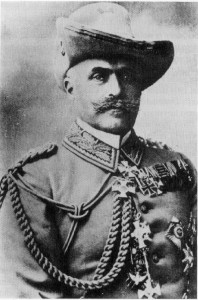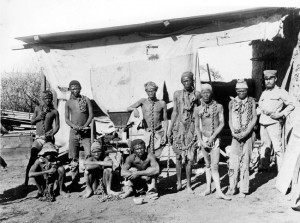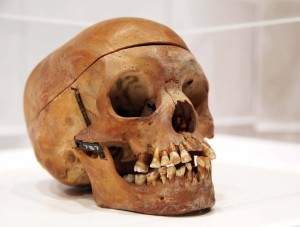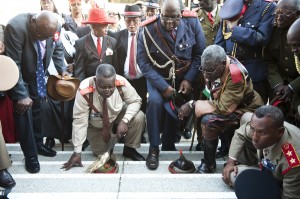In 1904, the Nama and Herero tribes of what was then the colony of German South West Africa revolted against their imperial oppressors. Herero killed between 123 and 150 German soldiers in a surprise attack in January. Governor Theodor Leutwein requested reinforcements which arrived in May under the command of Lieutenant-General Lothar von Trotha. Trotha was not interested in surrender or negotiation. His experience of slaughtering other African tribes circularly confirmed that the only way to deal with this set of African tribes was by slaughtering them too.
After General Trotha defeated 5,000 Herero soldiers at the Battle of Waterberg in August of 1904, he ordered his troops to chase the fleeing tribespeople into the Kalahari Desert (called the Omaheke by the Herero) and kill them all, combatant or civilian, armed or unarmed, men, women and children. What rifle and bayonet did not accomplish, the desert would.
 On October 2, Trotha read a proclamation to his officers:
On October 2, Trotha read a proclamation to his officers:
I, the great general of the German soldiers, send this letter to the Hereros. The Hereros are German subjects no longer. They have killed, stolen, cut off the ears and other parts of the body of wounded soldiers, and now are too cowardly to want to fight any longer. […] The Herero nation must now leave the country. If it refuses, I shall compel it to do so with the Groot Rohr [literally “long tube” meaning cannon]. Any Herero found inside the German frontier, with or without a gun or cattle, will be executed. I shall spare neither women nor children. I shall give the order to drive them away and fire on them. Such are my words to the Herero people.
The great General of the mighty German Kaiser.
The German command was aware of and approved the plan, describing it in Der Kampf, the official newsletter of the general staff, as a “bold enterprise [that] shows in the most brilliant light the ruthless energy of the German command in pursuing their beaten enemy. No pains, no sacrifices were spared in eliminating the last remnants of enemy resistance. Like a wounded beast the enemy was tracked down from one water-hole to the next, until finally he became the victim of his own environment. The arid Omaheke was to complete what the German army had begun: the extermination of the Herero nation.”
 It worked. Between 1904 and 1907, the Herero population plummeted from 80,000 to 15,000. Half of the Nama (about 10,000 people) were killed during the uprising, many of the rest imprisoned. According to a 1985 United Nations report, the Namibian genocide bears the dubious distinction of being the first genocide of the 20th century and the first organized state-run genocide ever.
It worked. Between 1904 and 1907, the Herero population plummeted from 80,000 to 15,000. Half of the Nama (about 10,000 people) were killed during the uprising, many of the rest imprisoned. According to a 1985 United Nations report, the Namibian genocide bears the dubious distinction of being the first genocide of the 20th century and the first organized state-run genocide ever.
Although by the end of 1904 the official policy towards the Herero changed from kill-on-sight to capture and imprisonment in concentration camps, the mortality rate in the camps was astronomical. As in later German camps, prisoners were systematically raped, starved, beaten, shot, hanged, worked to death, and subject to medical experimentation including deliberate infection with smallpox and typhus.
 Eugen Fischer, the scientist who performed these experiments, also used prisoners to pursue his racial theories, studying them when they were alive and decapitating them once they were dead so their skulls could be sent back to Germany for further study. Contemporary reports describe women prisoners being made to prepare the skulls for shipment, boiling the flesh and stripping it off with glass shards. Fischer would later teach medicine at the University of Berlin where at least one of his students, a certain Josef Mengele, would take his teachings very much to heart.
Eugen Fischer, the scientist who performed these experiments, also used prisoners to pursue his racial theories, studying them when they were alive and decapitating them once they were dead so their skulls could be sent back to Germany for further study. Contemporary reports describe women prisoners being made to prepare the skulls for shipment, boiling the flesh and stripping it off with glass shards. Fischer would later teach medicine at the University of Berlin where at least one of his students, a certain Josef Mengele, would take his teachings very much to heart.
Those skulls remained in German hospital and university archives for a century until three years ago when a German reporter discovered a number of them at the Berlin Medical History Museum of the Charité Hospital and at Freiburg University. The discovery made international news, spurring the Namibian government to officially request repatriation of any Herero and Nama skulls. Identifying which skulls came from which area was a challenge. Finally 20 skulls from Charité were identified. Eleven of them are Nama and nine Herero, four of them from women, 15 from men and one from a boy.
 On Friday, the 20 skulls were returned to a delegation of 55 Namibian Herero and Nama dignitaries in a formal ceremony at the Charité Hospital. This is probably just the first of many such ceremonies to follow. There are thousands of skulls from the colonial period and other times in German collections still to go through.
On Friday, the 20 skulls were returned to a delegation of 55 Namibian Herero and Nama dignitaries in a formal ceremony at the Charité Hospital. This is probably just the first of many such ceremonies to follow. There are thousands of skulls from the colonial period and other times in German collections still to go through.
unbelievable. What we are capable of doing to one another.
Alas, it is all too “believable” – and that’s the problem! The Herero-Nama slaughter was “the first genocide of the twentieth century and the first state-run genocide ever”. And then people stopped noticing…
“Who, after all, speaks today of the annihilation of the Armenians?”, to quote an influential student of history (and even that quote is now “controversial”). Or else, to quote an old friend of mine, “They keep raising the bar. Now, you can have six million before anyone raises an eyebrow.”
“Genocide” is a notoriously slippery concept since the eradication of whole populations in order to secure territory goes back as far as historians wish to delve. However, shipping skulls off to Berlin for “study” does seem to signal the advent of a Brave New World.
From a simple (and perhaps politically convenient) historical perspective it’s easy to see the German slaughter of Jews as a fit of collective madness, or rooted solely in a fairly widely known historical tradition of European antisemitism. This fascinating and horrifying post reminds us that the attitudes, practices, and even the very people implicated in “Final Solution” were tested, honed and institutionally ingrained in Germany’s African adventure. There just seems no end to the pockets of disease that spread over space and time from that era of colonialism.
Beautifully put.
its a sad story its a sad history to make matters worse. about 4000 farms in namibia are still owned by white germans. while the black people still suffer. many of these farms are not being used for production but lie iddle while their owners are in Germany. you will find that one person owns about five farms. the good thing about we Namibians is that we are very humble people and we love peace. im just thinking if it were other african countries how the situation would have been. i thus urge people to start realising Namibia is a peacefull democratic country that has gone through alot and continues to thrive against all odds. currently Namibia has discovered 16bilion barrels of oil and is set to start production by 2015. this will make it one of the biggest oil producers in africa. aftr libya and Algeria. on top of that Namibia is blessed with Diamonds,Gold,Beef,fish, wild animals and perfect wether. may the lord bless Namibia